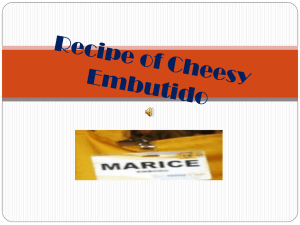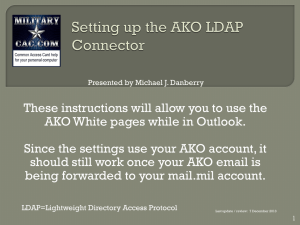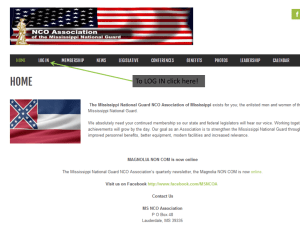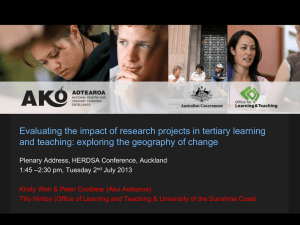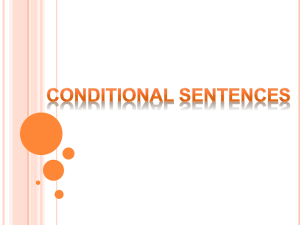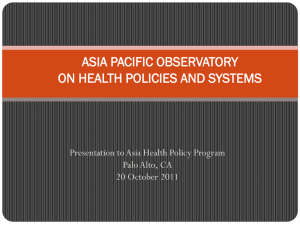PowerPoint resentation - Association for Media Education in Scotland
advertisement
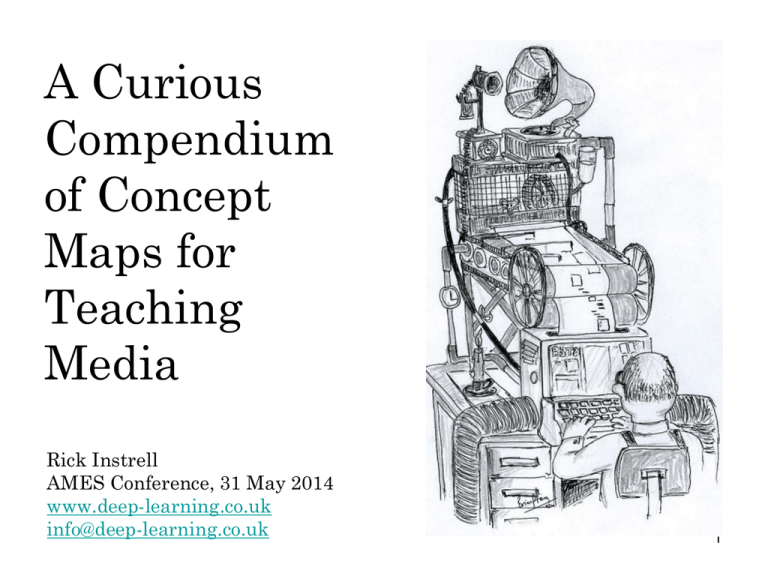
A Curious Compendium of Concept Maps for Teaching Media Rick Instrell AMES Conference, 31 May 2014 www.deep-learning.co.uk info@deep-learning.co.uk 1 Mind maps • A mind map is a diagram with words, ideas, actions, etc. linked and arranged radially round a central keyword or idea e.g. spider map • Good for brainstorming and first stage of planning media content etc. • Mind maps tend to be unorganised and personal • But we can help learners by use of mind map templates • Examples: – brand/product mind maps – compass diagram 2 Brand/product mind maps Products Price Service Quality BRAND/ PRODUCT Weaknesses USPs Access Reputation 3 Example of brand mind map Products: Big Mac, fries, … Service: fast, child friendly Price: cheap, promotions Quality: consistent Weaknesses: predictable, unhealthy USPs: fast, cheap, childfriendly Access: 24/7, malls Reputation: charities 4 Compass diagram Purpose/ target audience Research 1 Cultural codes 2 8 Internal/ external opportu3 nities /constraints Technical 7 codes 4 6 Style Media/ Genre 5 Content 5 What is a concept map? • Graphical representation of knowledge in form of a network with nodes and links • Nodes are concepts usually in the form of words • Links have labels with words or symbols that specify the relationship between the concepts • Linked nodes form meaningful statements (propositions) • Arrow on link indicates direction of relationship (may be two way) • A table also can be a good concept map • Based on a finite set of structures that the brain uses to represent the world cognitively 6 Concept map of concept maps OUTCOMES CONCEPT MAP • Meaningful teaching & learning • Graphical representation of knowledge in the form of propositions • Metacognition • Lifelong study skill APO APO Node = concept • Can be word(s)/symbols • Represent objects/ideas/events /states Cluster • Show as set or bulleted list Key: AKO = is a kind of APO = is a part of AFO= is a feature of AFO Link =Relationship Structure • Can be word(s)/symbols AKO AKO Contrast • Show as table AKO AKO Chain AKO Sequence • Show as scale, numbered list, sequence of boxes Tree = Hierarchy AKO Cycle = Helix • Show as loop AKO AKO Kind Tree =Taxonomy Part Tree = Partonomy • Show as tree diagram • Show as tree diagram 7 Word fields • Word Fields =Semantic Fields=Lexical Fields • A word field is a set of relations between concepts or word(s) • It is a conceptual structure e.g. – City/country is a word field unified a relation of opposite meaning – Hamlet/village/town/city is a word field organised on a scale of increasing size • Alan Cruse has performed a systematic overview of word fields – his terminology has been simplified here 8 Clusters • Word field with low degree of contrast e.g. – – – – • amble, stroll, saunter, … brave, courageous, fearless, heroic, plucky, … rap, tap, knock, slap, crack, bang, thump, … odd, queer, strange, weird, alien, … Best represented as a set or as a bulleted list (next slide) rap • tap knock In concept maps a cluster can be a set of features associated with a concept which has no apparent structure – best shown as bulleted list 9 Example: voice quality Voice quality • tense/relaxed • loud/soft • high/low • rough/smooth • breathy/non-breathy • vibrato/plain • nasal/non-nasal Voice quality AFO tense/relaxed OR loud/soft high/low rough/smooth breathy/non-breathy vibrato/plain nasal/non-nasal Key: AFO = is a feature of Adapted from Speech, Music, Sound, T van Leeuwen (1999London: Palgrave Macmillan, p151 10 Contrasts: opposites • Complementaries: e.g. – dead: alive; true: false • Converses: e.g. – buy:sell; parent: child • Polar opposites: e.g. – long: short; high: low; hot: cold • Reversives: e.g. – rise: fall; dress: undress; open: close • Best shown as a table with features of each opposite listed underneath 11 Example: conceptions of media Model Market model Public service model Conception Private companies selling products Public resources serving the public Main Purpose Profit for owners & shareholders Active citizenship via information, education & social integration Audience Consumers Citizens Service Entertainment, ads Information & education about the world Innovation Innovation threatens profitable standardised formats Innovation way of engaging audiences Diversity Strategy for reaching niche & upmarket audiences Represents range of public’s view and tastes Public interest Whatever is popular Diverse, substantial, innovative content even if not always popular Regulation Perceived as interference Protecting public interest Performance criteria Profit Serving public interest Example Sky BBC Adapted from The Business of Media, D Croteau and W Hovnes (2001) Thousand Oaks, CA: Pine Forge Press, p37. Q. Are Sky and BBC really polar opposites? What about ITV, C4, Five? 12 Concepts and conceptions • • • • Scholars may agree over the usefulness of concepts such as ‘media’, ‘institution’, ‘audience’ and society However they may have different conceptions of these concepts Concepts unify a field of study but rival conceptions divide it Different conceptions of a concept can be most economically shown in a contrast table rather than a diagram i.e. a conception map 13 Example: sociological theories Conception Marxism/Conflict theory Functionalism Symbolic Interactionism View of Society Society is a social arena in which diverse groups with conflicting values and interests compete for scarce resources: wealth, power, and prestige. Economic base; superstructure; social class; class consciousness; vested interests; alienation; power; coercion; domination; negotiation. Society is a social system made up of interdependent parts, all of which must fulfil certain functions to operate properly. Organic analogy; manifest and latent functions; equilibrium; dysfunctions. Society is like a stage where people define and redefine meaning as they interact with one another. View of Media Media are tools of power that help maintain the status quo, cultivate consumers, and disseminate info that serves interests of wealthy and powerful people/corporations that own/control the media. Media perform many social functions: dissemination of information/ideas; provision of instantaneous world-wide communication. Strengths Macrolevel analyses; social stratification; inequality. Macrolevel analyses; structure; institutions. Weaknesses Microlevel analyses; ignores cooperation. Microlevel analyses; ignores conflict and diversity. Major Concepts and Ideas Meaningful symbols; definition of the situation; looking-glass self; symbolic interaction; dramaturgical analysis; labelling. Media provide most effective methods of defining the situation to promote products through ads; politicians stage media events to promote agendas and careers; activist organizations use websites. Microlevel analyses; face-toface interaction; day-to-day activities. Macrolevel analyses; ignores structure and larger social forces. 14 Chains • Chains: series of terms that can be placed on a line e.g. – Stages in time e.g. • birth, life, death; nursery, primary, secondary; events as source, path, goal – Sequences in space e.g. • elbow, forearm, wrist, hand; core, mantle, crust – Measures e.g. • bit, byte, kilobyte, megabyte, terabyte – Ranks e.g. • teacher, principal teacher, depute head, head – Cycles (or helices): e.g. • spring, summer, autumn, winter • Best represented as a linear sequence or a cycle 15 Example: 4-act structure Time Stage Film: (Prologue) Act 1: Setup Turning point Act 2: Complicating action Turning point Act 3: Development Turning point Act 4: Climax (Epilogue) Adapted from Storytelling in the New Hollywood, K Thompson (1999) Cambridge, Massachusetts: Harvard University Press. 16 Example: The Hero’s Journey The Hero(ine)’s Journey is used by scriptwriters as a template for many mainstream Hollywood movies. Adapted from The Hero with a Thousand Faces, J Campbell (1949) Novato, CA: New World Library. 17 Trees (or hierarchies) • Kind tree (taxonomy) – categorisation using superordinate and subordinate categories • Part-tree (partonomy) – breaking a whole into its main parts and sub-parts • How you categorise or partition depends on educational context (subject, age, stage) 18 Part-tree (partonomy) BODY APO APO APO Limbs APO Leg AKO Shoulder Head APO APO Arm APO Upper Arm Face Trunk APO APO Ears Hair APO Elbow Bold words are basic level categories: words we most commonly use and the first we learn Note that this would be better represented by a labelled diagram of a human body. Key: APO = a part of 19 Problem of tree ‘spread’ BODY APO APO APO Limbs APO Leg APO APO Arm Head APO Face Trunk APO APO Ears Hair APO Thigh Shoulder Knee Upper Arm Shin Elbow Calf Forearm Ankle Wrist Foot Hand Key: APO = is a part of At the foot of a tree use a ‘ladder’ 20 Example: print ad elements headline copy images (photographs, pack shot of product, graphics) slogan (strapline) logo Kind-tree (taxonomy) TABLEWARE AKO AKO AKO Cutlery AKO Fork AKO Crockery AKO Knife AKO Teaspoon AKO Spoon Cup AKO AKO Soupspoon AKO Plate Table linen AKO AKO Bowl Napkin AKO Table cloth Tablespoon Bold words are basic level categories: words we most commonly use and the first we learn Key: AKO = is a kind of 22 Example: differential decoding Key: AKO = is a kind of AEO = is an example of AUDIENCE DECODINGS AKO Dominant decoding = preferred reading - agrees with intended preferred meanings AKO Negotiated decoding - agrees with some of preferred meanings & disagrees with others Oppositional decoding - understands preferred meanings but disagrees with them AEO AEO AEO Uncritical acceptance of Muller Little Stars ad’s message AKO Understandiing the ad’s message about health properties of yoghurt but thinking that its sweet taste will not be beneficial Viewing ad as promoting unhealthy addictive food as well as consumerist ideology AKO Aberrant decoding - misunderstands preferred meaning(s) because of different cultural background/lack of knowledge AEO Child viewing ad and thinking product comes straight from the field 23 Constrained concept maps • Can have many links so it is a good idea to apply Occam’s razor (parsimony) to the types of link: • e.g. restrict links to around 5 types: – is a kind of (AKO) – is part of (APO) – is a feature of (AFO) – is an example of (AEO) – arrowed line with no link word (leads to) • Parsimony works well in subjects such as computing but is less easy in media studies and other social sciences 24 Planning constrained maps • AKO: for each concept think of superordinate and subordinate categories • APO: for each concept think of superordinate and subordinate parts • AFO: what are the key features that pupils need to know? • AEO: think of real world example in pupils’ experience • Questions: should you place a kind-tree and a part-tree on the same map? • Questions: might a part-tree be better represented as a labelled image? 25 Applications of concept maps • • • • • • • • • • Clarification of one’s own conceptual understanding Unifying departmental approaches Advanced organisers and summaries Better for poor readers Diagnosis of conceptual misunderstandings Encourages deep meaningful learning rather than surface rote learning Encourages students to create and reflect on their own maps Shows how concepts are stored in experts’ minds Can use graphics as well as words and colour to help understanding on concept map Encourages metacognition and lifelong learning 26 Concept map integrating KAs TECHNOLOGY TEXTS Categories Language Narrative Representations create/ encode construct mode of address & preferred meanings UGC: user-generated content MEDIA INSTITUTIONS with purposes feedback used by/ decoded by applying cultural knowledge AUDIENCE differential decoders with needs MONEY influences SOCIETY Institutions, relationships & culture (lived cultures + texts) influences 27 Circuit of meaning expanded TEXTS CATEGORIES: purpose, medium, form, genre, tone, style. … create/encode INSTITUTION LANGUAGE: technical/cultural codes & their motivations & interactions e.g. anchorage. Construct: NARRATIVE: content organisation; narrative structure & narrative codes Preferred meanings Mode of address REPRESENTATIONS: stereotypes & non-stereotypes; ; hegemony; dominant/oppositional ideologies • creative personnel, deadlines, resources MEANING AUDIENCE create UGC • financial controllers (budget, income from sales, subscription, advertising; license fee) used by/decoded by applying cultural knowledge • target audience • needs, uses & pleasure feedback TECHNOLOGY • technologies of production, distribution & consumption • ownership & purposes (commercial, public service, alternative) •controls (legal & regulatory compliance, market) • differential decoders (personality, gender, age, class, ethnicity, religion, nationality, taste, cultural capital) • producers CAPITAL SOCIETY influences • institutions, relationships & culture (lived culture + texts) at specific times in specific places influences Time Bibliography Bordwell, D. (1989) Making Meaning: Inference Rhetoric in the Interpretation of Cinema. Cambridge, MA: Harvard University Press. Chapter 5 contains an accessible summary of Cruse’s ideas. Cruse, D. A. (1986) Lexical Semantics. Cambridge: Cambridge University Press. Key text on semantic fields but has a lot of difficult terminology. Cruse, D. A. (2000) Meaning in Language: An Introduction to Semantics and Pragmatics. Oxford: Oxford University Press. University level linguistics text book. Finch, J. (2006) Inspiration in the Classroom: Curriculum-based Activity Plans. Beaverton, Or: Inspiration Software Inc. Purchase from www.inspiration.com website. McQuail, D. & Windahl, S. (1993) Communication Models for the Study of Mass Communication (2nd edition). London: Routledge. Novak, J. & Gowin, D. B. (1984) Learning How to Learn. Cambridge: Cambridge University Press. Key text on concept mapping. Novak, J. (1998) Learning, Creating and Using Knowledge: Concept Maps as Facilitative Tools in School and Corporations. Mahwah, NJ: Lawrence Erlbaum Associates. Novak, J. D. & Cañas, A. J. (2006) The Theory Underlying Concept Maps and How to Construct Them. Florida Institute for Human and Machine Cognition. Available at: http://cmap.ihmc.us/Publications/ResearchPapers/TheoryUnderlyingConceptMaps.p df 29
